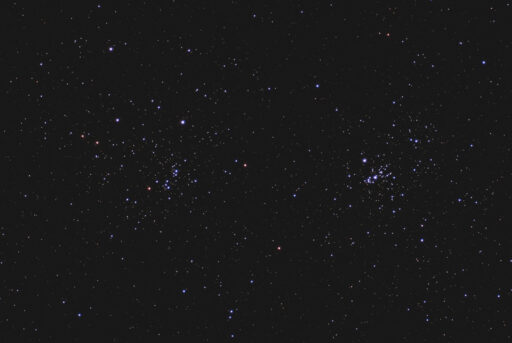
Telescope: Unitron 510 5” f/16 refractor, Atlas EQ-G
Camera: Canon EOS Ra full frame DSLR
Filter: 2” ZWO IR Cut Filter
Guide scope: Williams Optics 50mm Guidescope, ASI290MM, PHD
Exposure: 72x60sec, ISO 1600, saved as RAW
Darks: Internal (Long Exposure Noise Reduction)
Flats: 32×1/125s sky flats taken at dusk
Average Light Pollution: Bortle 8, poor transparency, haze
Lensed Sky Quality Meter: 18.1 mag/arc-sec^2
Stacking: Mean with a 1-sigma clip
White Balance: Nebulosity Automatic
Software: Backyard EOS, Deepsky Stacker, Nebulosity, Photoshop
This is the second of 3 bonus images that I grabbed as part of my latest imaging run with the 510. I was really curious to see how well the scope would frame this field and I thought that it turned out rather well. This is the full, uncropped field and does a good job showing just how flat the field of the 510 is even across a full frame sensor.
For a long time there was some debate as to whether the two clusters that make up the Double Cluster are actually associated with each other or just happened to appear in the same line of sight with one lying behind the other. It now appears that they are indeed lying next to each other, each about 7,000 light years away and about 100 light years apart. However, there is some evidence that the two clusters are of different ages, so while they may have formed separately from each other, they are now traveling companions.
The double cluster is currently low in the northeast during the early evening. Note that these two clusters lie on an east/west line as shown, however as they rise they will appear along a vertical line relative to the horizon. (Photo credit; John Graham, 8–18-2023.)
Recent Comments